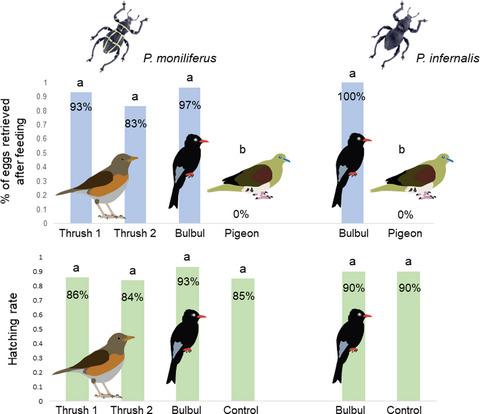当前位置:
X-MOL 学术
›
Ecol. Evol.
›
论文详情
Our official English website, www.x-mol.net, welcomes your
feedback! (Note: you will need to create a separate account there.)
Eggs survive through avian guts—A possible mechanism for transoceanic dispersal of flightless weevils
Ecology and Evolution ( IF 2.3 ) Pub Date : 2021-05-03 , DOI: 10.1002/ece3.7630 Si-Min Lin, Tsui-Wen Li, Chia-Hsin Liou, Ace Kevin S. Amarga, Analyn Cabras, Hui-Yun Tseng
Ecology and Evolution ( IF 2.3 ) Pub Date : 2021-05-03 , DOI: 10.1002/ece3.7630 Si-Min Lin, Tsui-Wen Li, Chia-Hsin Liou, Ace Kevin S. Amarga, Analyn Cabras, Hui-Yun Tseng

|
How flightless animals disperse to remote oceanic islands is a key unresolved question in biogeography. The flightless Pachyrhynchus weevils represent repetitive colonization history in West Pacific islands, which attracted our interests about how some weevils have successfully dispersed in the reverse direction against the sea current. Here, we propose endozoochory as a possible mechanism that the eggs of the weevils might be carried by embedded in the fruits as the food of frugivorous birds. In this study, Pachyrhynchus eggs were embedded in small pieces of persimmon fruits (Diospyros kaki) and fed to captive frugivorous birds. After digestion, 83%–100% eggs were retrieved from the feces of a bulbul (Hypsipetes leucocephalus) and two thrushes (Turdus chrysolaus). The retrieved eggs had hatching rates higher than 84%, which were not different from the control. In contrast, no egg was retrieved from the feces of the frugivorous pigeon (Treron sieboldii), which took a longer retention time in the guts. Our study identified that the eggs of Pachyrhynchus weevils are possible to be transported by internal digesting in some bird species.
中文翻译:

卵通过鸟类肠道存活——不会飞的象鼻虫跨洋传播的可能机制
不会飞的动物如何分散到偏远的海洋岛屿是生物地理学中一个尚未解决的关键问题。不会飞的厚嘴象鼻虫代表了西太平洋岛屿上重复的殖民历史,这引起了我们对一些象鼻虫如何逆着海流成功地逆向扩散的兴趣。在这里,我们提出内生动物作为一种可能的机制,即象鼻虫的卵可能通过嵌入水果中携带,作为食果鸟类的食物。在这项研究中,厚嘴龙的卵被嵌入小块柿子( Diospyros kaki )中,并喂给圈养的食果鸟。消化后,从一只鹎 ( Hypsipetes leucocephalus ) 和两只画眉 ( Turdus chrysolaus ) 的粪便中回收了 83%–100% 的卵。回收卵的孵化率高于 84%,与对照卵没有差异。相比之下,食果鸽( Treron sieboldii )的粪便中没有取出卵,因为它们在肠道内的保留时间较长。我们的研究发现,厚嘴象鼻虫的卵可能通过某些鸟类的内部消化进行运输。
更新日期:2021-06-22
中文翻译:

卵通过鸟类肠道存活——不会飞的象鼻虫跨洋传播的可能机制
不会飞的动物如何分散到偏远的海洋岛屿是生物地理学中一个尚未解决的关键问题。不会飞的厚嘴象鼻虫代表了西太平洋岛屿上重复的殖民历史,这引起了我们对一些象鼻虫如何逆着海流成功地逆向扩散的兴趣。在这里,我们提出内生动物作为一种可能的机制,即象鼻虫的卵可能通过嵌入水果中携带,作为食果鸟类的食物。在这项研究中,厚嘴龙的卵被嵌入小块柿子( Diospyros kaki )中,并喂给圈养的食果鸟。消化后,从一只鹎 ( Hypsipetes leucocephalus ) 和两只画眉 ( Turdus chrysolaus ) 的粪便中回收了 83%–100% 的卵。回收卵的孵化率高于 84%,与对照卵没有差异。相比之下,食果鸽( Treron sieboldii )的粪便中没有取出卵,因为它们在肠道内的保留时间较长。我们的研究发现,厚嘴象鼻虫的卵可能通过某些鸟类的内部消化进行运输。











































 京公网安备 11010802027423号
京公网安备 11010802027423号